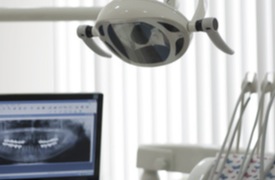
Dental radiology involves imaging the mouth and gums with advanced equipment. Traditionally, and still to this day, x-rays are used. This is done by projecting x-rays through the teeth and allowing them to strike a photosensitive plate or a digital sensor. The varying densities of the teeth create a grayscale image of the mouth and the internal structures of the teeth themselves.
Where normal x-ray film must actually be developed much like regular negatives, digital images usually appear instantaneously on a screen. Digital images of the teeth, however, have long suffered from a lack of resolution and detail. This is why so many standard x-ray film machines are still in use today.
Dental radiology is progressing, however, just as the rest of radiology is. There are a variety of new machines that can create panoramic images of the mouth all at once, removing the need for dentists to lace together separate x-rays manually. Computed tomography, also called CT scans, are also being used more frequently now to help image the entire mouth.
The images that are produced from dental radiology help the dentist to diagnose and catch problems that may not have been obvious from an oral examination. These scans can reveal evidence of decay inside of the tooth or in the root. It can also detect fractures below the gum line or damage to the jaw or other bones.
Dental radiology is also invaluable for finding cysts and abscesses. It can detect teeth that have not broken through the gums yet, or that are growing up through the gums misaligned and may require surgery.
Imaging the mouth in this way aids dentists and oral surgeons by allowing them to locate and isolate the exact area where a procedure must be performed. This can help to save the integrity of the entire tooth, where without the images the dentist would have to drill into the tooth and perform a kind of exploratory procedure that could leave it with an unnecessarily large opening.
Patients benefit from x-rays because they can show conditions that are developing in the gums and mouth which can be treated before they escalate into a larger problem. Also, since dentists can use the x-rays to reduce the amount of tooth that must be removed for certain procedures, the patient can keep more of their natural teeth.
Dental radiology is an invaluable asset for dentists, which is why they are a staple in every office.
Wiki User
∙ 13y agoAdd your answer:
What are the benefits of nighthawk radiology?
"According to some job review sites, Nighthawk Radiology seems to be a good place to work. They offer good medical and dental benefits that is affordable for the employee. Also, they offer flexible hours."
What classes are required for dental radiology?
To qualify for certification in dental radiology you need to already be a dental assistant or dentist. Typically, you'll then need 30 hours of continuing education courses to write the dental radiology exam.
What is the term 'dental radiology' commonly known as?
The term "Dental Radiology" is commonly known as "Dental X-Ray" and it is used in dental medicine terminology. Dentists use X-rays to take pictures of teeth.
Where can I major in dental radiology?
The best place to find information about dental radiology online is at WebMD.com. This website will give you a great wealth of medical information.
What does a dental radiologist do?
Once you get a dental radiology certification you would get work in a dental office scanning and xraying teeth. You will also be analysising the images for the dental office as well.
What must a dental assistant have in order to take dental x-rays?
What must a dental assistant have in order to take dental x-rays?Answer is B. certification in radiology
What has the author Frank L Ingram written?
Frank L. Ingram has written: 'Radiology of the teeth and jaws' -- subject(s): Dental Radiography 'Radiology of teeth and jaws, including dental radiography' -- subject(s): Radiography, Teeth
What special subjects are needed in dental health?
Some of the special subjects needed in dental health include imaging or radiology and dental bridge and affixed work. These subjects include building dental appliances.
What was the dental specialty became the first new dental specialty in 36 years when it was granted recognition by the ADA in 1999?
Oral and Maxillofacial Radiology (AAOMR)
What is overlapping in radiology dental?
Either teeth are overlapped, or poor technique when taken X-rays.
What has the author Eric Whaites written?
Eric Whaites has written: 'Radiography and Radiology for Dental Nurses' -- subject(s): Dental Radiography, Dental assistants, Methods, Nurses' instruction, Radiography, Teeth
Dental specialty fields for new dental assistants?
Endodontics, orthodontics, pediatrics, oral and maxillofacial surgery, oral and maxillofacial radiology, periodontics, pediatrics, and general dentistry.
